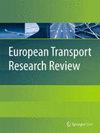在合作、互联和自动化时代,路边停车法规如何影响交通、安全和环境?
IF 4.2
3区 工程技术
Q1 TRANSPORTATION
引用次数: 0
摘要
作为交通基础设施的一部分,路边停车是一种常用的停车设施形式。然而,联网和自动驾驶汽车(CAV)的出现预计将对未来的停车产生重大影响。本研究旨在调查 CAV 路边停车法规对混合交通车队的环境、安全和流动性的影响。为实现这一目标,我们选择了英国莱斯特市经过校准和验证的网络模型,以测试在各种部署情况下 CAV 的实施情况。结果显示,用行车道、自行车道和公共空间取代路边停车位可以带来更好的交通性能。具体而言,与其他测试措施相比,行车时间可减少 27%-30%,延误可减少 43%-47%,排放可减少 90%以上,交通事故可减少 94%。相反,用接送站取代路边停车位的影响可能较小,因为车辆在接送乘客时会增加走走停停的情况,导致更多的交通中断和延误。本文举例说明了在 CCAM 时代可对路边停车实施的干预措施及其预期影响,以便区域决策者和地方当局制定相关政策。通过以更高效的交通措施取代路边停车,城市可以显著改善流动性、减少排放并提高安全性。本文章由计算机程序翻译,如有差异,请以英文原文为准。
How can on-street parking regulations affect traffic, safety, and the environment in a cooperative, connected, and automated era?
On-street parking is a commonly used form of parking facility as part of transportation infrastructure. However, the emergence of connected and autonomous vehicles (CAVs) is expected to significantly impact parking in the future. This study aims to investigate the impacts of on-street parking regulations for CAVs on the environment, safety and mobility in mixed traffic fleets. To achieve this goal, a calibrated and validated network model of the city of Leicester, UK, was selected to test the implementation of CAVs under various deployment scenarios. The results revealed that replacing on-street parking with driving lanes, cycle lanes, and public spaces can lead to better traffic performance. Specifically, there could be a 27–30% reduction in travel time, a 43–47% reduction in delays, more than 90% in emission reduction, and a 94% reduction in traffic crashes compared to the other tested measures. Conversely, replacing on-street parking with pick-up/drop-off stations may have a less significant impact due to increased stop-and-go events when vehicles pick-up and drop-off passengers, resulting in more interruptions in the flow and increased delays. The paper provides examples of interventions that can be implemented for on-street parking during a CCAM era, along with their expected impacts in order for regional decision-makers and local authorities to draw relative policies. By replacing on-street parking with more efficient traffic measures, cities can significantly improve mobility, reduce emissions, and enhance safety.
求助全文
通过发布文献求助,成功后即可免费获取论文全文。
去求助
来源期刊

European Transport Research Review
Engineering-Mechanical Engineering
CiteScore
8.60
自引率
4.70%
发文量
49
审稿时长
13 weeks
期刊介绍:
European Transport Research Review (ETRR) is a peer-reviewed open access journal publishing original high-quality scholarly research and developments in areas related to transportation science, technologies, policy and practice. Established in 2008 by the European Conference of Transport Research Institutes (ECTRI), the Journal provides researchers and practitioners around the world with an authoritative forum for the dissemination and critical discussion of new ideas and methodologies that originate in, or are of special interest to, the European transport research community. The journal is unique in its field, as it covers all modes of transport and addresses both the engineering and the social science perspective, offering a truly multidisciplinary platform for researchers, practitioners, engineers and policymakers. ETRR is aimed at a readership including researchers, practitioners in the design and operation of transportation systems, and policymakers at the international, national, regional and local levels.
 求助内容:
求助内容: 应助结果提醒方式:
应助结果提醒方式:


